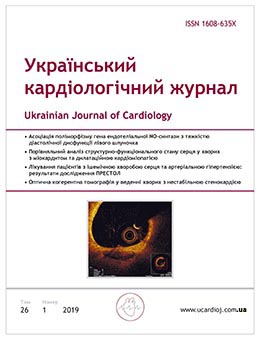Comparative analysis of structural and functional heart state in patients with chronic myocarditis and dilated cardiomyopathy
Main Article Content
Abstract
The aim – to establish differences in the structural and functional state of the heart in patients with chronic myocarditis and dilated cardiomyopathy and to investigate their associations with the presence of cardiac rhythm disorders.
Materials and methods. We included 95 patients who were divided into two groups: the first group consisted of
55 patients with chronic myocarditis (CM), the second group included 40 patients with dilated cardiomyopathy (DCM). All patients had heart failure (HF) II or higher functional class (FC) according to the classification of the New York Heart Association (NYHA) and a reduced left ventricular (LV) ejection fraction (EF). All patients underwent the echocardiography (EchoCG) with speckle tracking (ST), Holter electrocardiogram monitoring and cardiac magnetic resonance (CMR) imaging.
Results and discussion. A comparative analysis of the EchoCG data revealed that CM was characterized by lower values of LV end-diastolic and end-systolic volume indexes (by 21.7 and 28.6 %, respectively, p<0.01) and by 16.8 % (p<0.05) higher value of LV EF compared to DCM; when studying the results of ST EchoCG, it was found that in patients with CM, the absolute values of the longitudinal, circumferential and radial global systolic LV strain were by 25.0; 23.7 and 28.5 %, respectively, higher compared with patients with DCM (p<0.05–0.01). The obtained data were confirmed by the results of 6-minute walking test, so patients with DCM demonstrated the lower tolerance to physical exercise comparing with CM. When performing CMR in patients with CM, along with inflammatory changes in the myocardium (edema and hyperemia), fibrotic changes were present, while DCM was characterized only by diffuse fibrotic changes of the heart. The association between the presence of delayed enhancement on CMR and episodes of unstable ventricular tachycardia was proved for both CM and DCM – the result of Fisher’s exact test was p=0.019 and p=0.027 respectively.
Conclusions. In patients with DCM compared with CM we found more significant impairment of the structural and functional state of the heart, that was manifested by the presence of the worst heart failure functional class and a lower tolerance to exercise test. It has been established that fibrotic changes of the myocardium both in CM and in DCM are associated with the presence of ventricular arrhythmias, including such potentially dangerous ones as episodes of unstable ventricular tachycardia.

